The fabulous world of Jenny Fischer
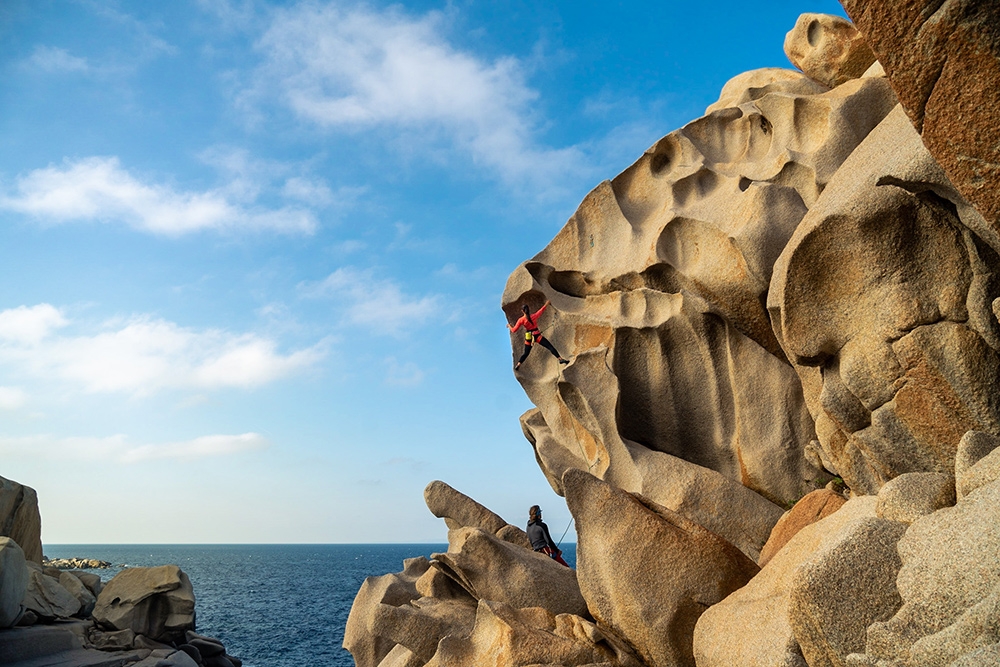
 1 / 6
1 / 6 Jenny Fischer archive
Jenny Fischer archive
Ciao Jenny, I’m a fan of yours on Instagram and I’ve been following you for a while. I’ve noticed that you’ve been a lot in Italy lately. What’s happened, have you fallen in love with this country?
Thank you for following the journey. It’s been quite the ride this year. We have been in Italy now since last October, and yes we have definitely fallen in love with it! It’s far more beautiful that I even knew to expect, and in our experience Italians and their lifestyle have been very friendly, I feel like Italy in general seems to have a good attitude. There’s a crazy amount of variety across the country too. From the alps and granite valleys in the north to the beaches of Sardinia and Sicily, there’s so many different experiences to have. The original plan for this past year actually did not include Italy at all, but with the pandemic we ended canceling all of our other global travel and instead made a back up plan to explore Europe. But by last fall Coronavirus was surging across most countries again and so we’ve decided to simply move less altogether and stay where we were, which happened to be in Italy.
What places did you visit? What did each of these give you?
The areas we have been to so far are Cadarese, Finale, Sicily and Sardinia. Not a lot for 7 months time but we’ve spent long periods of time in both Sicily and Sardinia rather than moving around the mainland. (Which was impossible for most of the past winter due to Corona restrictions.) Finale was my first real encounter with Italian limestone, and a humbling one at that! The style and grades were a real adjustment for me, but thankfully the beautiful coast and local foods soothed my struggles. Cadarese was a short and more focused visit, we were only there for 3 or 4 days. It was cold and at the very end of the season, but I really wanted to try a big offwidth roof there and had been missing crack climbing in general. I even ran into some other Americans that were there looking for some familiar climbing as well.
Then you decided to migrate south...
From Cadarese we moved to Sardinia, which is just magic as far as I can tell. The wilderness on the island is incredible; so much undeveloped land and forests, which reminds me of the big open spaces I miss from the US. But also, the Sardinian beaches are like paradise, plus the crazy eroded rock shapes of Capo Testa, the massive cliffs of the Supramonte and the wind carved granite of Capo Pecora. There’s just so many truly unique and different little corners on the island. It’s one of the best places I’ve ever been, and I’m not just saying that because you’re asking the interview questions!
And then you ended up in Sicily
Lastly we spent the coldest months of winter in Sicily, split between Siracusa and Sand Vito Lo Capo. Sicily was pretty much a training ground of limestone. We spent as much time as our bodies would tolerate on steep terrain to get stronger and work on weaknesses. Unfortunately, for most of the time we were in Sicily almost everything was closed due to holiday season restrictions. Which makes me wonder what life is like there, and actually in any of the places we’ve been, during non pandemic times. We’ve really enjoyed the nature and the rocks but have been very isolated from from the lifestyle of what I think Italy is like under normal times.
I’ve not managed to find out much about you and your past, but if I’m right it looks like you’re more than comfortable climbing cracks. So what’s it been like on the Italian limestone? Two styles of climbing that are somewhat different!
It’s true! I’m far more comfortable on cracks. Cracks have always made more sense to me, and jamming felt very natural from the first cracks I climbed. Also, due to some knee injuries I suffered a few years ago, cracks were the only safe thing for me to climb for quite awhile. So I’ve put a lot more time in on that style and unfortunately, neglected finger strength and sport climbing over the years. Right away on the limestone I noticed all kinds of ways in which I’m weak for that style, particularly in lock offs for long reaches and finger strength for pockets, but also, that I climb too slow because I’m used to looking for stances for assessing terrain and placing trad gear.
However, above style and strength, the rock itself has been the biggest learning curve for me. The style is a matter of technique adjustment and building some strength, but the different features of limestone are so unfamiliar to me. Of course there is limestone in the US but because of my crack fixation I never spent any time on it, so it’s very difficult for me to read and trust the rock. The texture and shapes are so inconsistent and unfamiliar, I frequently find myself climbing and feeling so lost or not knowing how or what to hold on the rock. Often it looks like everything could be a hold and I get exhausted hunting for something I can grab onto. It’s been equal parts frustration and comedy for me.
Usually when we Italians hit the American granite, we go through hell! It seems impossibly hard, and depressing when we see local climbers waltz up heinous cracks. It’s hard to believe that the same Americans might have a hard time at our crags. Do you reckon the style of climbing is a question of attitude or habit?
I feel that pain! It’s demoralizing to have to project a grade you are used to warming up on. It’s been really funny to me to hear Italian climbers describing granite. They use all the same words I use to describe limestone. Insecure, slippery, difficult to read... The analogy that comes to mind is that it’s like speaking a different language. I feel a certain level of comprehension on granite. There’s a very organic communication with my body to shift certain ways and I understand the friction for how secure the feet are, or how much torque I need on my fingers. On limestone it feels like I’m trying to have a conversation in a foreign language. I imagine it’s the same for limestone climbers when they quest up a perfect granite crack. I think your comfort level is a matter of habit, but your ability to improve is all in the attitude Of being uncomfortably challenged. If you want to learn a new language you can easily do so, but anyone who has tried knows you need a lot of practice to be fluent. It won’t come in a weekend.
In the last few months di you also do some trad climbing, or did you promise yourself something like “for a year I’ll only go sport climbing”
I have to smile a little because promising myself anything climbing wise this year has been a bit of a fools errand. I love to climb and explore via climbing, whether its trad or sport is immaterial to that. Whatever is available is going to be good. Trad climbing is my comfort zone but it’s not readily available in the quantity or quality that I’m used to having in the US, so I knew this year would involve a lot more sport climbing, especially over the winter months we spent in Sicily. I really welcomed that as an opportunity to work on expanding strength and skills but as soon as we got back to Sardinia I was excited to go find some granite to put gear in. I like all the styles, alpine, ice climbing, bouldering, etc. At this point it doesn’t really matter where we go I’ll be excited for a change of pace.
On Instagram I noticed you returned twice or three times even to the small crag Villasimius. What did you like about this place? Is there anything about it that reminds you of the American crags, or did you go back fo a different reason.
First of all, Villasimius is just a beautiful spot. I think the environment and the beaches there fit just about anyone’s ideas of paradise and since we were there during the off season there was almost no one else around. Having Sardinian beaches to yourself is a pretty dreamy experience, it doesn’t really motivate you to move on quickly.
The climbing there is truly unique, I can’t say it’s like any American crags I know but it’s also entirely different from the limestone sport crags I’ve visited so far. The granite has the most amazing texture, it’s incredibly sticky rock, and the style of the routes flows from really technical slabs to bouldery moves on shapes like large volumes broken up with good rest stances between the sequences. It’s just really fun climbing with routes from 4c to 8a, so we didn’t run out of interesting things to work on. I was also a bit captivated by one of your hard slab routes there, Braille Trail, which from what I understand has not been repeated since it was put up due to a possible broken hold? I didn’t put it all together but it was a fun puzzle to work on and remains a fun project I’d go back to. So there may still be more Villasimius days in our future.
The photos you post always somehow manage to capture the attention of the climbers who follow you. But not only your posts, also your stories manage to entertain us with topics ranging from politics to you preparing dinner. What's the recipe for your success on social media, if you want to reveal it to us?
I’m not sure I have the recipe for success, but I’ve always tried to keep it authentic. I didn’t get into social media to build a following. I’m actually a pretty intense introvert in real life and started an Instagram just as an attempt to practice extroversion in a way that felt comfortable to me. Needless to say, it snowballed into something I never imagined happening. Between the posts and stories my account really just reflects what’s going on in my life. The reality is beyond being climbers we are all just people living lives, and as I move through different countries and lifestyles different aspects of that are relatable to people who follow me in different ways. So it’s fun to share a little bit of everything. Honestly, the more valuable interactions I end up having on the platform stem more from political discussions, grocery store adventures, dog stories, etc, rather than just the climbing. For me, there’s often more value in the exchange of those perspectives anyway.
I do get asked occasionally how to "do" social media and of course being creative and having good photos helps but the best advice I would give is just to be the truest you possible. The more you follow you the more others will too. I see lots of accounts focusing on noting how many tries for a redpoint, certain grades or training benchmarks and I’m over here posting photos of the warm up because it was the prettiest line at the crag or the one that captured the character of the area best. I don’t think either approach to sharing is right or wrong but social media can amplify this atmosphere of competition where everyone needs to constantly be getting stronger and climbing harder, which creates sort of a mono-culture of content at times. It’s the lines, places and geology that inspire me the most, so that’s what I carry on about on Instagram. I like to think it offers a wider range of inspiration and ideas rather than just focusing on the hard hard stuff all the time.
Some friends, commenting your photos, have stated. "She’s really good, and always posts spectacular photos!" Which leads me to the question: how important are grades in your climbing? I get the impression that you search for beautiful looking lines in special places, rather than following the difficult routes that are popular right now... or am I wrong?
Wow, thanks to whoever is complementing my photos! I’m very new at shooting them myself, but I try to capture the essence of the places I visit to give other climbers a feeling of what it’s like to climb there. You’re correct, grades do not mean much to me. I put effort into getting stronger because it unlocks the potential for more experiences but the grade is really just a loose guide for what to expect from an objective. I’ve actually tried to focus on grades more at times in the past but it just doesn’t inspire me and actually takes some of the enjoyment away from my climbing. I didn’t get into climbing to stack up a list of achievements anyway, I got into climbing because I needed to have adventures in my life. There’s lots of climbers out there chasing grades, and there’s nothing wrong with that, but I’m chasing the things I’ve never seen before. For me, a truly spectacular formation like Fluttuazioni 6a+ at Capo Testa is worth just as much as a splitter 7b finger crack or an 8b offwidth roof. There have been points in my climbing where I’ve wrestled with that clarity, especially since there can be a lot of community pressure centered on grades, but traveling so many different places and climbing so many different styles has only made me more certain that I’m much happier climbing for the experience, rather than the achievement of it.
Link: Jenny Fischer on Instagram



 Copia link
Copia link

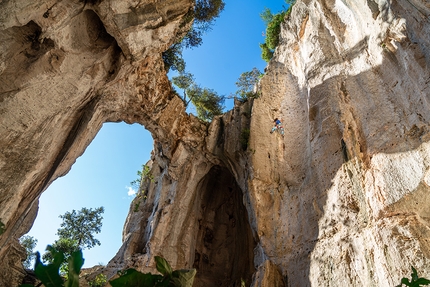
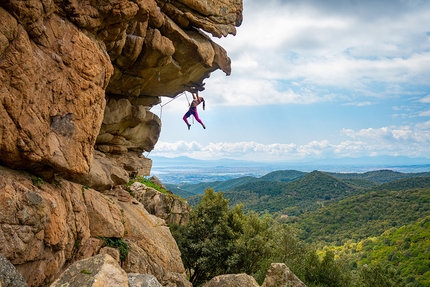
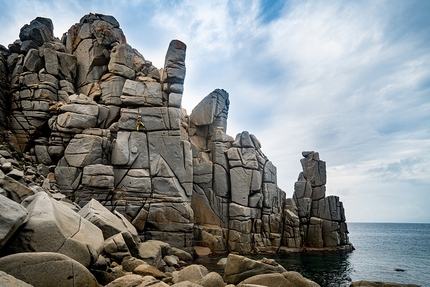
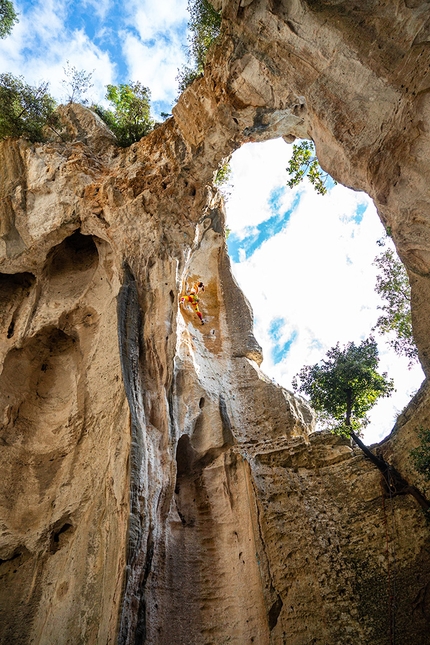
 See all photos
See all photos






















